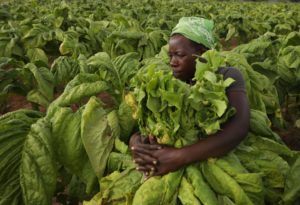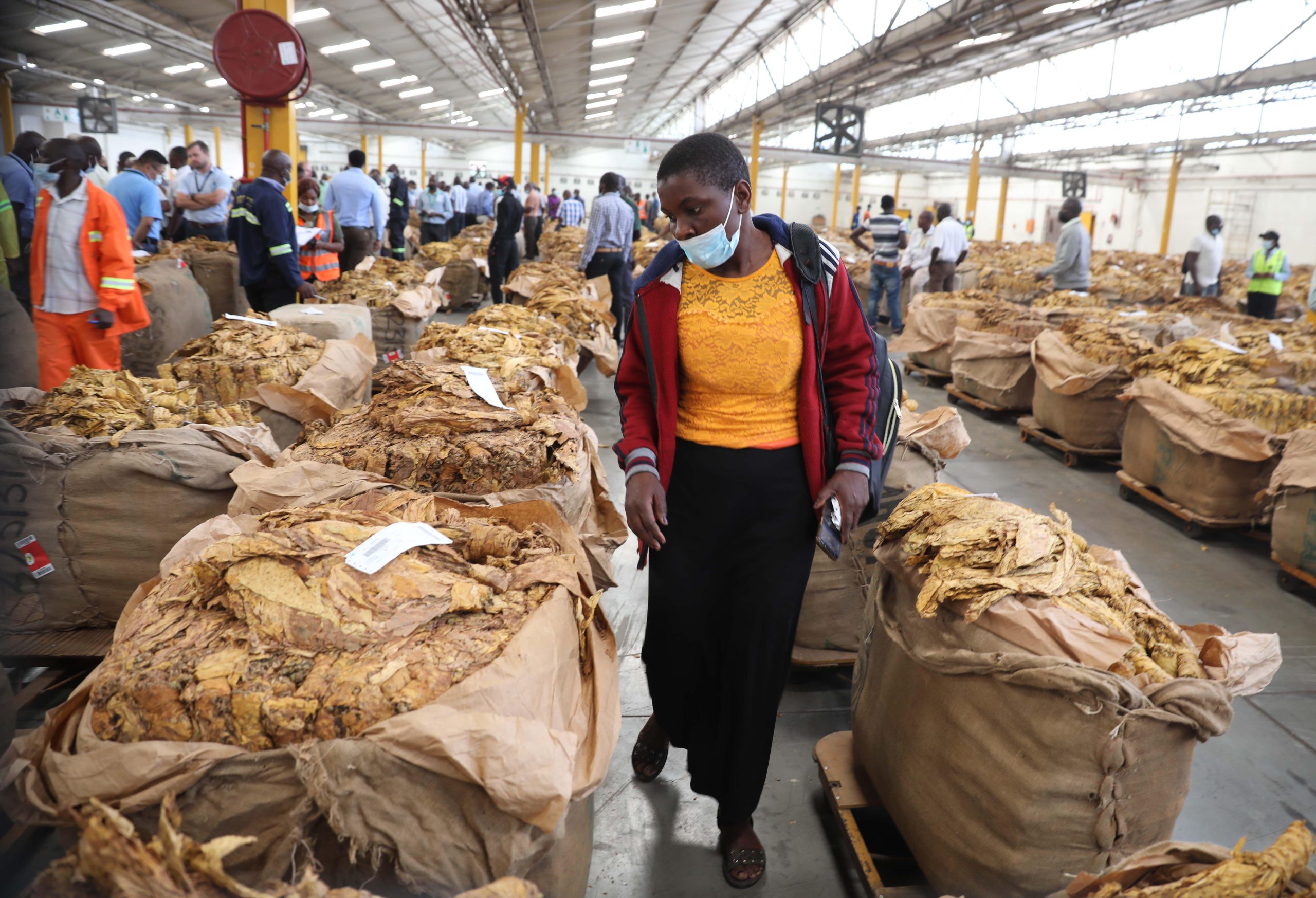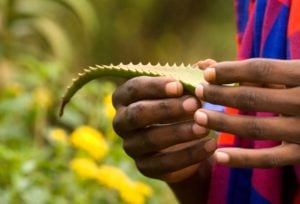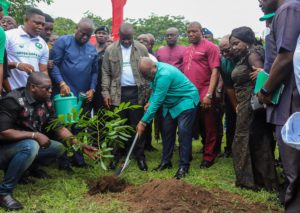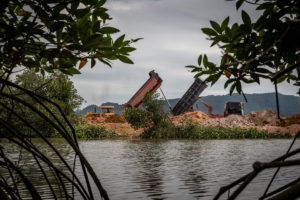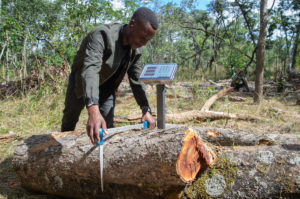At the beginning of this century, the Zimbabwean government embarked on an audacious land reform programme, ostensibly to correct the injustices suffered by local people when the land was colonised.
The controversial programme saw an estimated 170,000 black Zimbabwean families – mostly small-scale farmers – taking over agricultural production from about 3,000 white-owned farms.
After a decade under the shadow of macroeconomic mismanagement and hyperinflation, the black farmers became highly productive. As well as staple crops such as maize, they increasingly grew tobacco.
The number of tobacco farmers has continued to grow since, and by 2020, tobacco was Zimbabwe’s second largest foreign currency earner after gold mining.
Last year, the tobacco farmers sold more than 200,000 tonnes of leaf worth an estimated US$600 million, according to government figures cited by Xinhua.
The rise of tobacco as a key cash crop in Zimbabwe has, however, had consequences, most notably for the country’s forests.
Zimbabwe loses an estimated 262,000 hectares of forest annually and 15–20% of this loss is due to tobacco, according to Violet Matoko, a spokesperson for the country’s Forestry Commission.
To mitigate this, in 2015 the government brought in a levy for tobacco farmers. The idea was to include the sector within the country’s afforestation drive. It is hard to discern the long-term impacts of the policy. But local communities may start to benefit from new woodlots planted to reduce the strain on indigenous forests, the trees of which are widely used to cure tobacco.
How does tobacco cause deforestation?
A recent report by the World Health Organisation (WHO) states that tobacco has a “far more destructive impact on ecosystems” than other agricultural activities such as maize growing and even livestock grazing because “tobacco farm lands are more prone to desertification”.
In Zimbabwe, tobacco contributes directly to the expansion of the agricultural frontier at the expense of primary forest.
Perhaps the most important factor contributing to deforestation, though, is the use of indigenous trees for curing. Curing usually involves smoking the tobacco leaf over fires fuelled by trees such as msasa (Brachystegia spiciformis), munhondo (Julbernardia globiflora), mopani (Colophospermum mopane) and mukwa (Pterocarpus angolensis).
“Currently, the growing of tobacco is unsustainable, looking at the rate that the sector is contributing to deforestation,” said Violet Makoto.
“Deforestation does not only affect tobacco growing areas but the entire country, or globally, when we talk of climate change.”
Enhancing the afforestation drive
In an attempt to reverse the tree loss, Zimbabwe introduced a tobacco levy in 2015. Contractor farmers now have to contribute 1.5% of their tobacco revenue to the Sustainable Afforestation Association. The association uses the money in part to support the establishment of woodlots that can curb indigenous tree loss in the tobacco-growing regions of northern and eastern Zimbabwe.
The amount collected is also used to fund research into alternative methods for curing tobacco. In 2021, the levy generated US$8.8 million.
Makoto said: “Basically, this fund is expected to provide financial services to any afforestation programmes that are undertaken, whether it’s a tobacco growing area or not.”
She added that the Forestry Commission started receiving funds in the past three years to establish nurseries of eucalyptus, a kind of tree often favoured in plantations due to their fast growth.
Eucalyptus seedlings are distributed to farmers for free, with the commission offering free training and assistance under its Tobacco Wood Energy Programme to promote planting.
Conservation groups, however, are concerned about the impacts of eucalyptus on the water table and on native plant species. Makoto said: “Research is also ongoing to find other, indigenous tree varieties that have a fast growth rate that can be used for the same purpose.”
Makoto expressed concern that the small-scale farmers had very little land to spare for establishing woodlots.
“We are, however, encouraging the establishment of community woodlots,” she said.
The role of companies
Some of the largest contributors to the Tobacco Wood Energy Programme are international tobacco companies. They operate within the contract system, which was introduced in Zimbabwe in 2005. Under the system, a buyer, for example British American Tobacco, signs a contract with a farmer to purchase their entire crop at the end of a season. In return, the buyer supplies seed, fertiliser and other inputs.
According to Xinhua, 95% of Zimbabwe’s tobacco crop is grown under the contract system, while only 5% of farmers self-finance their production, which they then sell on auction floors.
Tian Ze Tobacco Company is a subsidiary of state-owned China Tobacco and the largest foreign-owned tobacco firm operating in Zimbabwe. It does not own land in the country but works under the contract system. It has been a member of the Sustainable Afforestation Association since it was established in 2013.
Tian Ze’s public affairs manager, Li Wenjie, told China Dialogue that through the levy the company contributes around US$900,000 to the tree-planting initiative each season, depending on how much raw tobacco it purchases.
The role of the regulator
Chelesani Moyo, spokesperson for the Tobacco Industry and Marketing Board (TIMB), which regulates tobacco in Zimbabwe, said: “The board has called upon all growers to re-orient their production practices to patterns that favour sustainability and satisfy the needs of the climate.” Moyo added that the board has “established a sustainability department to enforce the afforestation and reforestation projects in partnership with tobacco growers.”
She said the board is fully enforcing a national statutory instrument mandating the establishment of woodlots of at least 0.3 hectares per hectare of tobacco grown.
Moyo said farmers will only be able to renew their registration with the TIMB for the 2023/24 season if they have a woodlot with living trees.
“During the 2020/21 tobacco season, 150 hectares of eucalyptus trees were planted in Manicaland and 120 hectares in Mashonaland East,” she said, referring to provinces in the country’s east. “The TIMB has established partnerships with the Forestry Commission to distribute millions of tree seedlings to all willing tobacco growers.”
Moyo said the TIMB would be working with and through tobacco merchants or contractors in this 2022/23 season to spearhead tree-planting initiatives.
“Each contractor has access to all the growers they contract, therefore we will give them seedlings to distribute, monitor the planting, and care for the trees to maturity,” she said.
Creating economic opportunities
The Tobacco Wood Energy Programme has also helped farmers gain sponsorship to grow the woodlots.
For example, Pride Meki, a forester based in the district of Centenary, Mashonaland Central, supervises 10 farmers who have established 800 hectares of eucalyptus woodlots.
He helps farmers with tasks including planting, weeding, and pest and fire management.
“The farmers receive 20% from the sale of the mature and harvested [eucalyptus] gum poles while the [branches are] used for tobacco curing,” Meki said. “The farmers also work under contract to provide equipment such as tractors when we clear the land and create fire guards.”
The target is to harvest at least 100 cubic metres of fuel wood per hectare from the lots, which, Meki explains, is possible about eight to nine years after planting.
Besides getting the technical know-how of managing woodlots, and earning commission on sales of trunks, the farmers are paid for looking after the plantations.
The Tobacco Wood Energy Programme helps farmers identify the market for the wood while communities get work opportunities.
Meki says that in his cluster at least 150 local people have been employed. Villagers receive training in managing weeds and fires – skills they can use in their own fields.
Bernard Nyangoni, a farmer contracted to grow the woodlots, said the programme has reduced wildfire incidents at his farm, and habitat has been restored.
“I am looking forward to my first harvest this year and to receive payment. The most important issue has been the use of gum trees [eucalyptus] to cure my tobacco, but I have also earned some money from selling poles from the woodlot,” he said.
Lloyd Mubaiwa, business development manager at the Sustainable Afforestation Association, said the tree-planting programme has covered 22,000 hectares since 2014.
Rooting for indigenous varieties
Sydney Chisi is executive director of Reyna Trust, a Zimbabwean climate and social justice organisation promoting sustainability and green development. He said Zimbabwe could do more to complement efforts by contractors such as Tian Ze and other merchants. Moreover, much as some tobacco companies have established woodlots, from an environmentalist and climate change perspective, the eucalyptus species are dangerous, Chisi added.
For Zimbabwe, eucalyptus are not an answerSydney Chisi, executive director of Reyna Trust
He said they tap into underground water sources, use up all available water, and do not sustainably co-exist with other plant species.
“The idea of using eucalyptus as an alternative does not support our agenda of reclaiming our carbon sinks,” Chisi said.
“The government levies about US$0.75 per kilogram of tobacco sold at the auction floors.” That money is not being effectively used, he said.
He called for incentivising tree growing, adding that government should devolve the programme to involve traditional leaders in protecting forests.
Government, according to Chisi, could start by providing villagers and farmers with fruit trees while making sure they get a market for the produce.
“Authorities have assisted farmers and villagers in Mutoko [a small town in Mashonaland East] by establishing processing plants for fruits such as mangoes. If they incentivise growing of trees, especially fruit trees, and making sure they benefit, the villagers will not hesitate to grow them,” he said.
Chisi said these projects could be kick-started with fast-growing trees such as apple-ring acacia (faidherbia albida), fever tree (vachellia xanthophloea), munhondo (julbernardia globiflora) and species of the brachystegia genus.
“These trees can replace the eucalyptus because, for Zimbabwe, eucalyptus are not an answer to our afforestation programmes.
“Communities should also provide land for indigenous tree woodlots, while traditional leaders should be responsible for safeguarding and securing the woodlots.”
He said government should also promote carbon trading.
Carbon trading and tree planting pledges
The role of carbon trading in Zimbabwe is “under debate”, Chisi said. “Communities with carbon credits can access finance for development purposes at household and community levels. Those with indigenous tree woodlots can gain positive carbon credits and sell them to countries such as Germany, China and Japan.”
Zimbabwe signed afforestation protocols at the COP26 UN climate talks in 2021 but there are fears its government has not done enough to implement that pledge. At the same COP, the government also committed to planting 25 million trees in 2022. Finally, it pledged to reduce greenhouse gases emissions by 40% per capita by 2030 amid calls for a multi-sectoral approach towards achieving the targets.
While the Sustainable Afforestation Association has managed to grow 22,000 hectares of eucalyptus to partially offset forest lost due to tobacco farming, harvesting of these trees has not yet started to bring extensive benefits to farmers, hence the continued loss of indigenous trees for the curing of tobacco leaf.
